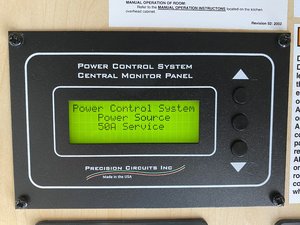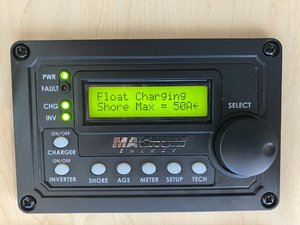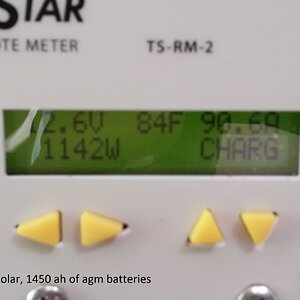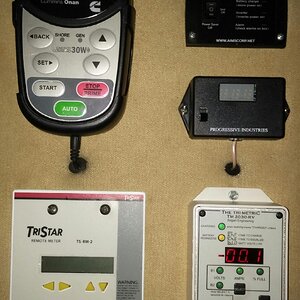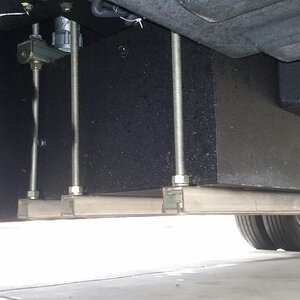Navigation
Install the app
How to install the app on iOS
Follow along with the video below to see how to install our site as a web app on your home screen.
Note: This feature may not be available in some browsers.
More options
Style variation
Welcome to RVForums.com
- Register now and join the discussion
- Friendliest RV Community on the web
- Modern site for PC's, Phones, Tablets - no 3rd party apps required
- Ask questions, help others, review campgrounds
- Get the most out of the RV Lifestyle
- Invite everyone to RVForums.com and let's have fun
- Commercial/Vendors welcome
You are using an out of date browser. It may not display this or other websites correctly.
You should upgrade or use an alternative browser.
You should upgrade or use an alternative browser.
Help Dead Battery!
- Thread starter MapNerd
- Start date
-
- Tags
- dead batteries help power
CoreyinWP
RVF VIP
- Joined
- Nov 3, 2019
- Messages
- 187
- Location
- West Palm Beach Fl
- RV Year
- 2017
- RV Make
- Newmar
- RV Model
- Ventana 4369
- RV Length
- 44
- TOW/TOAD
- Buick Enclave
redbaron
Moderator
- Joined
- Nov 3, 2019
- Messages
- 2,972
- RV Year
- 2022
- RV Make
- Newmar
- RV Model
- London Aire 4551
- RV Length
- 45
- Chassis
- Spartan
- TOW/TOAD
- 2020 Jeep Wrangler Unlimited Rubicon
You almost got me @TJ&LadyDi ! I started to write a post about the danger of oversizing your fuse....then read just how oversized you were going.Maybe this is the answer; my new replacement fuse!
View attachment 1339
Note the 3750A rating stamped on it! It came from a power company substation.
TJ
2019 DSDP 4369 * Active Air * NHSO
TJ&LadyDi
RVF "Dinosaur"
You are correct about the danger of oversizing a fuse. When circuits are designed, the wire gauge is a significant factor in the fuse size calculation. Upsizing the fuse creates the potential for wiring damage when the fuse does not open at the calculated amperage.You almost got me @TJ&LadyDi ! I started to write a post about the danger of oversizing your fuse....then read just how oversized you were going.
2019 DSDP 4369 * Active Air * NHSO
My 3750A fuse is a conversation piece, but won't find itself into the MADP.
TJ
redbaron
Moderator
- Joined
- Nov 3, 2019
- Messages
- 2,972
- RV Year
- 2022
- RV Make
- Newmar
- RV Model
- London Aire 4551
- RV Length
- 45
- Chassis
- Spartan
- TOW/TOAD
- 2020 Jeep Wrangler Unlimited Rubicon
Physically..how big is that thing? Looks like it could be the size of a jeep hood, but perspective is absent.You are correct about the danger of oversizing a fuse. When circuits are designed, the wire gauge is a significant factor in the fuse size calculation. Upsizing the fuse creates the potential for wiring damage when the fuse does not open at the calculated amperage.
My 3750A fuse is a conversation piece, but won't find itself into the MADP. [emoji23]
TJ
2019 DSDP 4369 * Active Air * NHSO
TJ&LadyDi
RVF "Dinosaur"
It's actually not that big; about 5" x 10" x 0.5" thick.Physically..how big is that thing? Looks like it could be the size of a jeep hood, but perspective is absent.
2019 DSDP 4369 * Active Air * NHSO
TJ
MapNerd
RVF 1K Club
- Joined
- Nov 17, 2019
- Messages
- 2,298
- Location
- Prince William, VA
- RV Year
- 2020
- RV Make
- Newmar
- RV Model
- Ventana 4326
- RV Length
- 43
- TOW/TOAD
- 2020 Ford F-150
- Fulltimer
- Yes
Well let me recap everything with all the information as I have it, in it’s corrected form and maybe that will put some of the questions at ease.
We were out for the day and when we came back, we came back to a perfectly functioning coach, not dead batteries as my original post indicates.
We walked in and DW got to making dinner while I got to salivating and panting. Now, we’d been hookup up to 30amp service for a week and a half without issue and I will freely admit, I’m kind of an “if it ain’t broke, don’t fix it” kinda guy. I say that because I plugged in, checked that there was power coming in and kicked back on my laurels, as I usually do. I’m not the guy watching all the systems like a hawk, but one thing I’ve learned from this experience is that I should watch them at least a little closer. A daily check of all systems in the cabinet wouldn’t interrupt the flow of my day.
So we came back to a coach. Wife was making some roasted veggies in the convection oven and some chicken wings in the Instant Pot Duo Air Fryer.
Kids are prepping the table and I’m getting ready to go take the bikes off the bike rack when everything shuts off. Now, the house lights didn’t miss a beat when this happened, so so I didn’t notice it right when it happened. DW told me we lost power but didn’t mention to me that she had just plugged in the Air Fryer and put it to work and the Convection Oven has been turned on just a few minutes before that.
So when she tells me I come inside to investigate and look at the Magnum Panel. The fault says “Dead Batt Charge” or something to that effect, there’s a pic of the panel earlier in the thread. The fault light is on and the charge light is flashing.
Being a rookie at this, I read the fault and think to myself, now how the heck did the batteries get discharged?! We’ve been hooked up the whole week! Did the power stop coming at the pedestal a couple of days ago? Why didn’t my Hughes Power Watchdog send me an alert if I wasn’t getting power?
So I go outside and check the Power Watchdog. It’s lit up white so I know its getting power from the pedestal and it’s not throwing any error codes on the device or at my phone.
Ha! It’s the inverter! I read about this on RVForums.com and that other place too so many times. Just gotta flip the breaker. Oh, the inverter breaker isn’t tripped. Well lets just reset it for good measure. Still no change. Alright, let’s go look at the inverter. Hmm. No lights. I remember this thing having lights on when it was humming. It’s definitely the inverter because the lights aren’t on. Let’s go look at the manual...
Blah blah blah, Yadav Yada - ah, there it is.
Dead Batt Charge
Remedy: Check the DC voltage on the inverter’s DC terminals and ensure it is the same as the battery bank. These two voltages should be very close (<0.5 VDC difference). If not, check to ensure all connections are tight and the fuse/circuit breaker between the inverter and battery bank is good.
This fault automatically clears if the AC power is removed or when the voltage is greater than 12.6 volts.”
Now for some reason, only the last sentence meant anything to me. Everything else might as well not have been there because I (stupidly) completely ignored it all. All I took in was “The fault automatically clears if the AC power is removed or when the voltage is greater than 12.6 volts”
Got it. Magnum panel says I’m at .5 volts. No idea how these batteries got so discharged but if I just get them back up to 12.6 volts, the fault will clear! Let’s turn on the generator. So I flip on the generator and watch the panel, nothing is changing. Maybe it takes some time I think to myself. I let it run for a solid 15-20 minutes and the voltage reading on the panel doesn’t move an inch. Okay, power is not making it to the batteries from the generator or shore power. @FLSteve and @VTPete mention the generator breaker and the 300amp fuse.
I check the generator breaker and its set to on. I do a continuity test on the 300amp fuse and get tone, so I’m thinking that can’t be it. If the fuse is blown I should not get tone from a continuity test. I also do a voltage test but this was my mistake. I checked the voltage going through the fuse by putting the negative probe on the metal clamp holding one side of the fuse, and the positive probe on the metal clamp holding the other side of the fuse and I see 12.6 volts. The proper way to do this test is to put your negative probe on the negative terminal of a battery and the positive probe on on the metal clamp holding the fuse after current passes through the fuse and heads into the house. Had I done that, I would have seen there is no current flowing past the fuse. But, I don’t know that at this point and I’m thinking the fuse is fine.
So now, I’m definately thinking its the inverter or the transfer switch. Those are the only two things that make any sense. I’d also tested the battery voltage while I was in that bay and I was getting 6.4 volts off of each battery, so those puppies are fully charged and my magnum panel is either lying to me or more likely, I dont know how to interpret what it’s saying to me.
Give Newmar a call, they’re stumped. Start talking to @Neal who is also talking to @redbaron and we’re running tests on the inverter, resetting it and everything. Nothing is changing. It’s late, the batteries are fully charged, we’ve got hot water, we’re in southern FL so nothing will freeze overnight and Newmar will be sending a tech the next day. We can survive the night so I call it quits. While all of this was going on, my wife had finished up our dinner at the neighbor’s (I thanked the gentleman and gave him a bottle of Titos as a token of appreciation since we was fond of vodka).
The next morning, I have to run an errand and I’ve heard so much about these 300amp fuses blowing that I decide to grab one at an O’Reilly’s Autoparts store just to keep on hand in case that happens. When I get back that afternoon, I decide to just try and replace it. Maybe I tested something wrong or my multimeter is smoking something. I pop in the new fuse and everything roars back to life. It was the fuse the whole time.
So a couple of lessons here.
1. Read the manual and do what it says in its entirety. Not just the last sentence. Had I done that, I would have solved it the night before (though I didn’t have another 300amp fuse on hand to correct it).
2. Pay attention to your systems. That wasn’t my problem here but it could have easily been. It was entirely possible initially that I’d lost power at the pedestal earlier in the week and didn’t know and my batteries had been discharging the entire time.
3. Learn how to use your multimeter. It’s an invaluable tool. I used it for almost every single test I performed but unfortunately, it was my first time ever using one so I didn’t know exactly what I was doing. Only had a vague idea.
4. Always post on RVForums.com and try to be as accurate as possible. I gave inaccurate descriptions and test results and several folks on here still knew what it was. The amount of knowledge here is amazing.
5. Carry extra 300amp fuses.
6. Always ask what happened two seconds before this incident.
Thanks to everyone who participated in helping me solve it. I hope this post helps someone else down the road.
We were out for the day and when we came back, we came back to a perfectly functioning coach, not dead batteries as my original post indicates.
We walked in and DW got to making dinner while I got to salivating and panting. Now, we’d been hookup up to 30amp service for a week and a half without issue and I will freely admit, I’m kind of an “if it ain’t broke, don’t fix it” kinda guy. I say that because I plugged in, checked that there was power coming in and kicked back on my laurels, as I usually do. I’m not the guy watching all the systems like a hawk, but one thing I’ve learned from this experience is that I should watch them at least a little closer. A daily check of all systems in the cabinet wouldn’t interrupt the flow of my day.
So we came back to a coach. Wife was making some roasted veggies in the convection oven and some chicken wings in the Instant Pot Duo Air Fryer.
Kids are prepping the table and I’m getting ready to go take the bikes off the bike rack when everything shuts off. Now, the house lights didn’t miss a beat when this happened, so so I didn’t notice it right when it happened. DW told me we lost power but didn’t mention to me that she had just plugged in the Air Fryer and put it to work and the Convection Oven has been turned on just a few minutes before that.
So when she tells me I come inside to investigate and look at the Magnum Panel. The fault says “Dead Batt Charge” or something to that effect, there’s a pic of the panel earlier in the thread. The fault light is on and the charge light is flashing.
Being a rookie at this, I read the fault and think to myself, now how the heck did the batteries get discharged?! We’ve been hooked up the whole week! Did the power stop coming at the pedestal a couple of days ago? Why didn’t my Hughes Power Watchdog send me an alert if I wasn’t getting power?
So I go outside and check the Power Watchdog. It’s lit up white so I know its getting power from the pedestal and it’s not throwing any error codes on the device or at my phone.
Ha! It’s the inverter! I read about this on RVForums.com and that other place too so many times. Just gotta flip the breaker. Oh, the inverter breaker isn’t tripped. Well lets just reset it for good measure. Still no change. Alright, let’s go look at the inverter. Hmm. No lights. I remember this thing having lights on when it was humming. It’s definitely the inverter because the lights aren’t on. Let’s go look at the manual...
Blah blah blah, Yadav Yada - ah, there it is.
Dead Batt Charge
Remedy: Check the DC voltage on the inverter’s DC terminals and ensure it is the same as the battery bank. These two voltages should be very close (<0.5 VDC difference). If not, check to ensure all connections are tight and the fuse/circuit breaker between the inverter and battery bank is good.
This fault automatically clears if the AC power is removed or when the voltage is greater than 12.6 volts.”
Now for some reason, only the last sentence meant anything to me. Everything else might as well not have been there because I (stupidly) completely ignored it all. All I took in was “The fault automatically clears if the AC power is removed or when the voltage is greater than 12.6 volts”
Got it. Magnum panel says I’m at .5 volts. No idea how these batteries got so discharged but if I just get them back up to 12.6 volts, the fault will clear! Let’s turn on the generator. So I flip on the generator and watch the panel, nothing is changing. Maybe it takes some time I think to myself. I let it run for a solid 15-20 minutes and the voltage reading on the panel doesn’t move an inch. Okay, power is not making it to the batteries from the generator or shore power. @FLSteve and @VTPete mention the generator breaker and the 300amp fuse.
I check the generator breaker and its set to on. I do a continuity test on the 300amp fuse and get tone, so I’m thinking that can’t be it. If the fuse is blown I should not get tone from a continuity test. I also do a voltage test but this was my mistake. I checked the voltage going through the fuse by putting the negative probe on the metal clamp holding one side of the fuse, and the positive probe on the metal clamp holding the other side of the fuse and I see 12.6 volts. The proper way to do this test is to put your negative probe on the negative terminal of a battery and the positive probe on on the metal clamp holding the fuse after current passes through the fuse and heads into the house. Had I done that, I would have seen there is no current flowing past the fuse. But, I don’t know that at this point and I’m thinking the fuse is fine.
So now, I’m definately thinking its the inverter or the transfer switch. Those are the only two things that make any sense. I’d also tested the battery voltage while I was in that bay and I was getting 6.4 volts off of each battery, so those puppies are fully charged and my magnum panel is either lying to me or more likely, I dont know how to interpret what it’s saying to me.
Give Newmar a call, they’re stumped. Start talking to @Neal who is also talking to @redbaron and we’re running tests on the inverter, resetting it and everything. Nothing is changing. It’s late, the batteries are fully charged, we’ve got hot water, we’re in southern FL so nothing will freeze overnight and Newmar will be sending a tech the next day. We can survive the night so I call it quits. While all of this was going on, my wife had finished up our dinner at the neighbor’s (I thanked the gentleman and gave him a bottle of Titos as a token of appreciation since we was fond of vodka).
The next morning, I have to run an errand and I’ve heard so much about these 300amp fuses blowing that I decide to grab one at an O’Reilly’s Autoparts store just to keep on hand in case that happens. When I get back that afternoon, I decide to just try and replace it. Maybe I tested something wrong or my multimeter is smoking something. I pop in the new fuse and everything roars back to life. It was the fuse the whole time.
So a couple of lessons here.
1. Read the manual and do what it says in its entirety. Not just the last sentence. Had I done that, I would have solved it the night before (though I didn’t have another 300amp fuse on hand to correct it).
2. Pay attention to your systems. That wasn’t my problem here but it could have easily been. It was entirely possible initially that I’d lost power at the pedestal earlier in the week and didn’t know and my batteries had been discharging the entire time.
3. Learn how to use your multimeter. It’s an invaluable tool. I used it for almost every single test I performed but unfortunately, it was my first time ever using one so I didn’t know exactly what I was doing. Only had a vague idea.
4. Always post on RVForums.com and try to be as accurate as possible. I gave inaccurate descriptions and test results and several folks on here still knew what it was. The amount of knowledge here is amazing.
5. Carry extra 300amp fuses.
6. Always ask what happened two seconds before this incident.
Thanks to everyone who participated in helping me solve it. I hope this post helps someone else down the road.
sheridany
RVF Supporter
RandyB
Retired
- Joined
- Nov 15, 2019
- Messages
- 459
- Location
- Portage, MI
- RV Year
- 2017
- RV Make
- Newmar
- RV Model
- Ventana LE 4037
- RV Length
- 40' 11"
- TOW/TOAD
- 2021 Chevy Trailblazer
- Fulltimer
- No
Throughout this entire saga, I kept wondering...why fuses, why not a circuit breaker? Then, especially wondered when I compared costs.


Perhaps that one little phrase for the fuse "Very Fast Acting"? Still makes me wonder, especially when every penny is pinched for productions costs. On top of that, the circuit breaker has visual evidence that it has tripped and if it has tripped it does not require a trip to the parts bin or parts store.
Perhaps that one little phrase for the fuse "Very Fast Acting"? Still makes me wonder, especially when every penny is pinched for productions costs. On top of that, the circuit breaker has visual evidence that it has tripped and if it has tripped it does not require a trip to the parts bin or parts store.
VTPete
RVF Supporter
- Joined
- Jan 26, 2020
- Messages
- 280
- Location
- Lakeside, CA
- RV Year
- 2017
- RV Make
- Newmar
- RV Model
- Ventana LE
- RV Length
- 40
- TOW/TOAD
- Ford F150 King Ranch
- Fulltimer
- No
thanks for the post-mortem Nerd. I think this all speaks well of our small but growing little community here-everybody contributed and some even a phone call!
Anyway-im left with a related question. when I blew my 300A fuse Not long after buying my coach, I was on 30A shore power, watching TV, and running front AC. I popped a treat in the Convection MW and bam, 300A fuse blown. Didn’t make sense to me at first but some of that load was obviously coming off the inverter and thus the batteries....
another time months later, I was on 50A,running a ceramic heater, convection oven, and the wife fired up a curling iron and this time a fuse popped on the Magnum vs the 300A fuseable link.
So I still can’t wrap my head around why the inverter seemingly hits the batteries so hard for DC current when shorepower is active on 30A, but not so much on 50?
Anyway-im left with a related question. when I blew my 300A fuse Not long after buying my coach, I was on 30A shore power, watching TV, and running front AC. I popped a treat in the Convection MW and bam, 300A fuse blown. Didn’t make sense to me at first but some of that load was obviously coming off the inverter and thus the batteries....
another time months later, I was on 50A,running a ceramic heater, convection oven, and the wife fired up a curling iron and this time a fuse popped on the Magnum vs the 300A fuseable link.
So I still can’t wrap my head around why the inverter seemingly hits the batteries so hard for DC current when shorepower is active on 30A, but not so much on 50?
AbdRahim
RVF Supporter
- Joined
- Dec 25, 2019
- Messages
- 3,923
- RV Year
- 2020
- RV Make
- Newmar
- RV Model
- BayStar 3626
- RV Length
- 37’
- Chassis
- Ford
- Engine
- V10
- TOW/TOAD
- None
RandyB
Retired
- Joined
- Nov 15, 2019
- Messages
- 459
- Location
- Portage, MI
- RV Year
- 2017
- RV Make
- Newmar
- RV Model
- Ventana LE 4037
- RV Length
- 40' 11"
- TOW/TOAD
- 2021 Chevy Trailblazer
- Fulltimer
- No
Remember that a 50 amp fed coach is really 2 feeds of 50 amp each. The coach is wired so that some of the items run off of leg #1 and the rest off leg #2. Leg #1 has 50 amp capability and leg #2 has 50 amp capability.
When connected to 30 amp service, there is only one hot feed and it is at 30 amps max. Depending on the coach and how the adapter is wired, one leg has ZERO amps and the other has only 30. So, you're really 70 amps underpowered. The inverter and the load shedding device (optional) tries to make up the deficiency. As you are finding out, it can't be done without blowing fuses.
The rules I try to enforce is without 50 amp shore power or the generator running, large wattage devices are forbidden to be run. These include: microwave, convection, coffee maker, portable heaters, water heater elements and even hair dryers. Not only is there the risk of blowing expensive fuses, but the battery drain is enormous trying to run those devices through the inverter.
Another important note regarding the Magnum control: make a habit of checking the shore power max setting. Press the “Shore” button and rotate the select knob to the desired setting of input amperage. If you have the power management optional equipment, make sure it too is set to the proper amperage.
When connected to 30 amp service, there is only one hot feed and it is at 30 amps max. Depending on the coach and how the adapter is wired, one leg has ZERO amps and the other has only 30. So, you're really 70 amps underpowered. The inverter and the load shedding device (optional) tries to make up the deficiency. As you are finding out, it can't be done without blowing fuses.
The rules I try to enforce is without 50 amp shore power or the generator running, large wattage devices are forbidden to be run. These include: microwave, convection, coffee maker, portable heaters, water heater elements and even hair dryers. Not only is there the risk of blowing expensive fuses, but the battery drain is enormous trying to run those devices through the inverter.
Another important note regarding the Magnum control: make a habit of checking the shore power max setting. Press the “Shore” button and rotate the select knob to the desired setting of input amperage. If you have the power management optional equipment, make sure it too is set to the proper amperage.
Attachments
Last edited:
MapNerd
RVF 1K Club
- Joined
- Nov 17, 2019
- Messages
- 2,298
- Location
- Prince William, VA
- RV Year
- 2020
- RV Make
- Newmar
- RV Model
- Ventana 4326
- RV Length
- 43
- TOW/TOAD
- 2020 Ford F-150
- Fulltimer
- Yes
300amp, not 30amp. It looks like a giant all’s-seltzer. There’s a pic of it earlier in the threadWow John. Thanks for the synopsis. I will put these fuses on my shopping list. I have about every other size, but not 30 amp. I have learned a lot here. I must admit, I would have eliminated the fuse after the continuity test as well. Thanks again.
FLSteve
RVF Supporter
- Joined
- Nov 18, 2019
- Messages
- 667
- Location
- Fort Myers, FL
- RV Year
- 2025
- RV Make
- Newmar
- RV Model
- New Aire 3547
- RV Length
- 35'
- Chassis
- Freightliner
- TOW/TOAD
- 2024 JL Rubicon
FLSteve
Anybody know what the 150 amp fuse feeds? The 350 amp is also "pinkish" so I will take my vote meter and make sure I know how to test these as you suggested. A good time to do this since we are home and it's sitting in the garage.
FLSteve
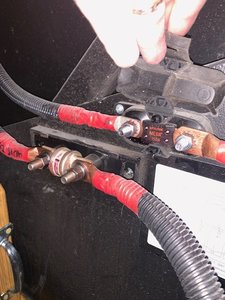
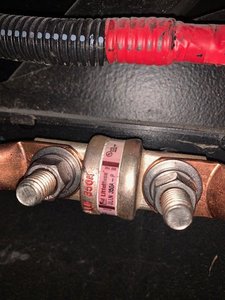
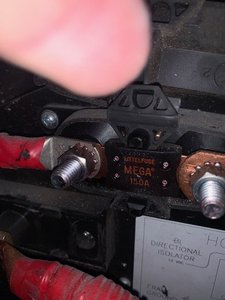
@MapNerd ... thanks for the detailed recap and you make some excellent points here. It's always good to hear how things wind up. Following this thread has really helped me should I ever get in this situation. As a result I decided to go look at my fuse just to make sure I have the proper replacement … and find that I actually have two (2) of them. A 350 amp and a 150 amp.Well let me recap everything with all the information as I have it, in it’s corrected form and maybe that will put some of the questions at ease.
So a couple of lessons here.
1. Read the manual and do what it says in its entirety. Not just the last sentence. Had I done that, I would have solved it the night before (though I didn’t have another 300amp fuse on hand to correct it).
2. Pay attention to your systems. That wasn’t my problem here but it could have easily been. It was entirely possible initially that I’d lost power at the pedestal earlier in the week and didn’t know and my batteries had been discharging the entire time.
3. Learn how to use your multimeter. It’s an invaluable tool. I used it for almost every single test I performed but unfortunately, it was my first time ever using one so I didn’t know exactly what I was doing. Only had a vague idea.
4. Always post on RVForums.com and try to be as accurate as possible. I gave inaccurate descriptions and test results and several folks on here still knew what it was. The amount of knowledge here is amazing.
5. Carry extra 300amp fuses.
6. Always ask what happened two seconds before this incident.
Thanks to everyone who participated in helping me solve it. I hope this post helps someone else down the road.
Anybody know what the 150 amp fuse feeds? The 350 amp is also "pinkish" so I will take my vote meter and make sure I know how to test these as you suggested. A good time to do this since we are home and it's sitting in the garage.
FLSteve



redbaron
Moderator
- Joined
- Nov 3, 2019
- Messages
- 2,972
- RV Year
- 2022
- RV Make
- Newmar
- RV Model
- London Aire 4551
- RV Length
- 45
- Chassis
- Spartan
- TOW/TOAD
- 2020 Jeep Wrangler Unlimited Rubicon
Similar threads
- Replies
- 9
- Views
- 867
Latest resources
-
-
Trueline Leveling System (Valid Air)Operation & Service Manuals for the Valid Air leveling system
- Jim
- Updated:
-
-
Notes on the Electrical Systems of the Roadtrek Zion Family of RVsNotes on the Electrical Systems of the Roadtrek Zion Family of RVs
- dilbertjth
- Updated:
-
